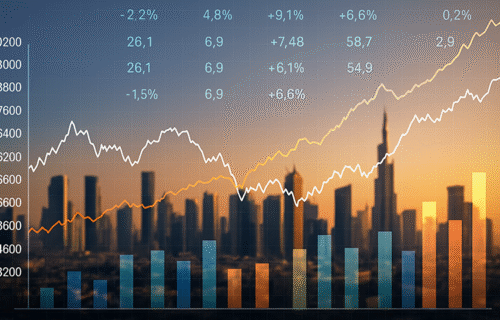The Gulf Cooperation Council (GCC) equity markets extended their positive streak into October 2025, with the MSCI GCC index rising 1.2% month-on-month, marking the second consecutive month of gains. The region’s performance reflected stronger global investor sentiment, progress in trade negotiations, and monetary easing following synchronized rate cuts by the US Federal Reserve and most GCC central banks — with Kuwait as the only exception.
Oman, Bahrain, and Dubai Lead Regional Gains
Oman emerged as the best-performing market, surging 8.3% and securing its fourth straight monthly advance. The rally, supported by sustained economic diversification and steady corporate earnings, placed Muscat’s bourse second in the GCC for year-to-date growth at 22.6%, just behind Kuwait’s 22.7%. Bahrain followed closely with a 5.9% rise, while Dubai climbed 3.8% on the back of strong performances in real estate and banking shares.
Kuwait continued to dominate regional benchmarks, with the All Share Index up 2.7% in October and breaching the symbolic 9,000-point threshold for the first time this year. Gains were driven largely by mid- and small-cap stocks, especially within financial services and energy. Saudi Arabia’s Tadawul posted a modest 1.3% gain as third-quarter earnings lifted sentiment, despite large-cap banks facing pressure over ongoing foreign ownership policy discussions.
Sector Snapshot: Diversified Financials, Energy, and Retail Drive Growth
Sector performance across the region tilted towards the upside. Diversified Financials led with a 6.6% increase, followed by Retail (+6.4%) and Utilities (+4.8%). Energy stocks benefited from higher oil prices and strong quarterly results, gaining 3.8%, while banks saw smaller advances at 0.7%. Consumer-facing industries such as apparel and hospitality lagged, recording declines between 2% and 10%.
Regional Market Highlights
In Abu Dhabi, the FTSE ADX Index rose 0.9%, buoyed by gains in financials and telecoms, even as real estate and utilities underperformed. Dubai’s Financial and Real Estate indices rose sharply, helped by strong corporate activity and continued inflows into property. The Qatar Exchange was the only market to end lower (-0.9%), dragged down by large-cap financials and real estate stocks despite solid 9M earnings from the banking sector. Bahrain’s All Share Index advanced 5.9%, supported by Aluminium Bahrain’s 22% surge and steady gains across non-oil sectors.
Meanwhile, Oman’s Muscat Stock Exchange delivered a standout performance as all sectors — led by services and financials — finished in positive territory. Rising trading volumes and the expansion of industrial activity reflected growing investor confidence.
Macroeconomic Backdrop and Policy Moves
Rate adjustments across the GCC largely mirrored the US Federal Reserve’s 25-basis-point cut in late October. Saudi Arabia’s central bank reduced its repo rate to 4%, while other regional regulators followed suit to support liquidity and maintain currency pegs. Economic data released by the IMF and national statistics agencies pointed to sustained non-oil growth across the Gulf, with Abu Dhabi’s GDP projected to rise by 6% in 2025 and Oman’s non-oil output up 4% year-on-year.
Outlook
Kamco Invest’s latest analysis underscores continued optimism for GCC equity markets heading into 2026, driven by supportive monetary policies, fiscal expansion, and improving corporate earnings. However, analysts caution that geopolitical risks, uneven oil demand recovery, and global inflation trends could influence near-term volatility.
Source: Kamco Invest, GCC Markets Monthly Report – October 2025.
